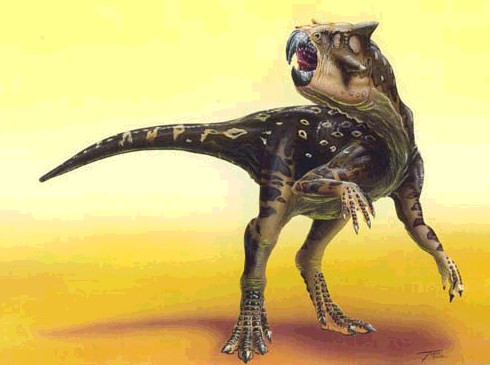 |
| A map showing the global distribution of the empire of the dinosaurs. Each red dot represents a location where dinosaur fossils have been found. |
As new dinosaur species were uncovered, however, it became clear that we had found their lost world, a new global empire. The Bone Wars fought between Othniel Charles Marsh and Edward Drinker Cope during the late 19th century resulted in a flood of new species, reptilian giants the like of which the early palaeontologists could scarcely imagine. Today, many dinosaurs, particularly from China, Mongolia and the Montana/Alberta region of North America, are uncovered. We have identified over 1000 non-avian species.
Yet there is a theory which suggests that there might not be as many dinosaur species as previously thought, while mature adults could be physiologically different to juveniles. Indeed a newborn human baby has around 350 bones, while a fully grown human has just 206. As a result, it is possible that many of the so-called dinosaur species are simply skeletons which represent different developmental stages of the same species. An expanded view of this theory suggests that other factors, such as the concept of naturally occurring dinosaur 'breeds' or warping during the fossilization process, may also have contributed to the long species list.
For a while, evidence to support this idea has been scarce, but recent analysis of fossils of the dinosaur Psittacosaurus has demonstrated, conclusively, that three species are actually one. Using a technique known as 3D geometric morphometrics to analyse Psittacosaurus skulls, Brandon Hedrick and Peter Dodson from the University of Pennsylvania were able to identify 'landmark points' of the skulls common to a single species.
 |
| An artist's impression of Psittacosaurus. |
The three used in this study all came from the Lujiatun ash beds of China's Yixian formation. This meant that they had close biological affinities which made for a focused study in considering the total biological, temporal and geographical distribution of Psittacosaurus.
The other reason for their choice of dinosaur was the sheer abundance of specimens. 'Meat-eaters are sexy; plant-eaters are not,' said Dodson. 'This isn't a flashy dinosaur. But it has an interesting feature in that it's one of the most abundant dinosaurs known to science.' Indeed, many hundreds of Psittacosaurus specimens have been found.
'If you have a single dachshund and a single beagle, they may appear to be different species until you found 40 dachshund-beagle mixes of various grades to examine,' said Hedrick. 74 specimens belonging to the three species and representing a variety of different characteristics to distinguish between them were examined using traditional methods and then cross-compared to eight other Psittacosaurus species.
 |
| A comparison of the landmark points on just two Psittacosaurus skulls. |
'Our study found all of these false 'species' that are not biological species but are apparent species caused by the process of fossilization,' said Dodson. 'Hopefully this will open up the palaeontological community to using three-dimensional geometric morphometrics in a variety of ways,' concluded Hedrick. Actually applying techniques to other species may prove to be more difficult, as no other dinosaur species has such an abundance in the fossil record as Psittacosaurus and other material is not as readily available.